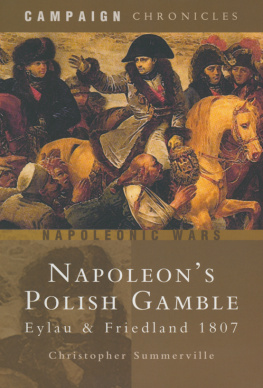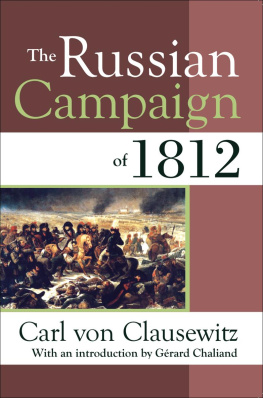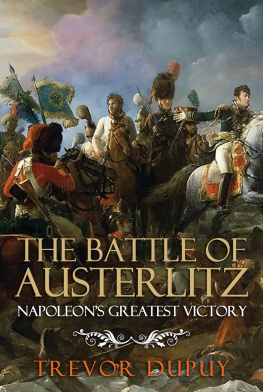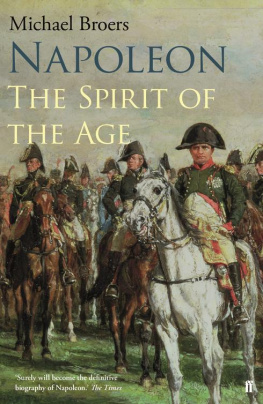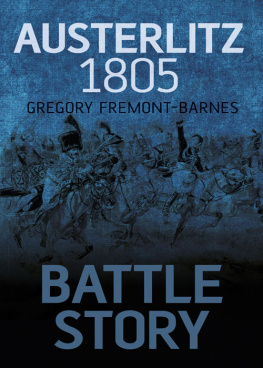
First published in Great Britain in 2005 by
Pen & Sword Military
an imprint of
Pen & Sword Books Ltd
47 Church Street
Barnsley
South Yorkshire
S70 2AS
Copyright Ian Castle 2005
ISBN 1-84415-171-9
PRINT ISBN: 9781844151714
EPUB ISBN: 9781844683291
PRC ISBN: 9781844683307
The right of Ian Castle to be identified as
Author of the Work has been asserted by
him in accordance with the Copyright, Designs
and Patents Act 1988.
A CIP catalogue record for this book is
available from the British Library
All rights reserved. No part of this book may be reproduced or transmitted in
any form or by any means, electronic or mechanical including photocopying,
recording or by any information storage and retrieval system, without
permission from the Publisher in writing.
Typeset in 11/13pt Plantin by Mac Style Ltd, Scarborough, N. Yorkshire
Printed and bound in England by CPI UK
Pen & Sword Books Ltd incorporates the Imprints of Pen & Sword Aviation,
Pen & Sword Maritime, Pen & Sword Military, Wharncliffe Local History, Pen
& Sword Select, Pen and Sword Military Classics and Leo Cooper.
For a complete list of Pen & Sword titles, please contact
Pen & Sword Books Limited
47 Church Street, Barnsley, South Yorkshire, S70 2AS, England
E-mail:
Website: www.pen-and-sword.co.uk
For Nicola,
Who actively indulges my passion for times long ago and willingly accompanies me on the historical path that I tread.
List of Maps
Authors Note
While researching this book I spent much time working with German, French and Russian language texts. In an attempt to retain some of the flavour of a multi-national war, I have decided to retain the ranks of army officers in their relevant languages, when naming individuals. I have occasionally used abbreviations for some senior officer ranks. A table is given below detailing these rank definitions and abbreviations for the readers convenience.
| English | French | Austrian | Russian |
| Lieutenant | Lieutenant | Leutnant | Porudchik |
| Captain | Capitaine | Hauptmann | Kapitan |
| Major | Chef de Bataillon (inf.) or de Escadron (cav.) | Major | Maior |
| Lieutenant Colonel | Major | Oberstleutnant | Podpolkovnik (PP) |
| Colonel | Colonel | Oberst | Polkovnik |
| Brigadier General | Gnral de Brigade (GB) | Generalmajor (GM) | Brigadir |
| Major General | Gnral de Division (GD) | Feldmarschal-leutnant (FML) | General Maior (GM) |
| Lieutenant General | No equivalent | Feldzeugmeister (FZM - infantry) or General de Kavallerie (GdK - cavalry) | General Leitenant (GL) |
In a similar vein, I also intended giving regimental titles in their respective languages. This has been relatively straightforward for the French and Austrian armies, examples of which are given below:
| French Army | English Comparable Version |
| 2me Rgiment de Hussards (abbreviated in text to 2me Hussards) | 2nd Hussar Regiment |
| 12me Rgiment de Dragons (abbreviated in text to 12me Dragons) | 12th Dragoon Regiment |
| 4me Rgiment dInfanterie de Ligne (abbreviated in text to 4me Ligne) | 4th Line Infantry Regiment |
| 26me Rgiment dInfanterie de Lgre (abbreviated in text to 26me Lgre) | 26th Light Infantry Regiment |
N.B. In addition to the above infantry abbreviations I have also used 1/4me Ligne and 2/26me Lgre to indicate 1st and 2nd battalions of particular regiments.
| Austrian Army | English Comparable Version |
| Infanterieregiment 4. Deutschmeister (abbreviated in text to IR4 Deutschmeister) | 4th Infantry Regiment Deutschmeister |
| 4. Hessen-Homburg-Husaren | 4th Hessen-Homburg Hussars |
| 1. Erzherzog Johann-Dragoner | 1st Archduke John Dragoons |
I hoped to operate a similar system for the Russian army (see examples below), but on reflection, it has been decided to use English translations of regimental titles, in order to simplify understanding of their roles.
| Russian Army | English Comparable Version |
| Novgorod Mushketyorskii Polk | Novgorod Musketeer Regiment |
| Phanagoria Grenaderskii Polk | Phanagoria Grenadier Regiment |
| 6. Egerskii Polk | 6th Jger Regiment |
| Mariupol Gusarskii Polk | Mariupol Hussar Regiment |
Another anomaly in the Russian army is the occasional use of numerals after officers names. This system was introduced because a great number of officers serving in the army had the same surname. For instance, there were three officers with the name Essen on active service in 1805 and they were known as Essen I, Essen II and Essen III.
The spelling of Russian officers names varies considerably in primary sources, and in Napoleonic literature in general. For the sake of consistency, I have followed the spellings given in Alexander Mikaberidzes authoritative The Russian Officer Corps in the Revolutionary and Napoleonic Wars, 17921815. This source has also been relied upon for regimental names.
Preface
I first visited the battlefield of Austerlitz in 1989 in the company of some 100 members of the Napoleonic Association, including in our number the late Dr David Chandler. Back then Czechoslovakia formed a Communist state and I remember our coaches being held at the border for five long hours while our paperwork was rejected and correct paperwork processed in its place. Later that year massive anti-government demonstrations led to the Velvet Revolution and the abandoning of former ties with the Soviet Union. Now Austerlitz lies in the Czech Republic (Czechia), member state of NATO and the European Union. When I visited Austerlitz again in 2000 it took less than five minutes to cross the border.
The battlefield is a rewarding place to visit as there has been little dramatic change to the terrain in the intervening 200 years. It is as simple to explore all the key geographical features of the battle today as it is to imagine the armies of France, Russia and Austria marching across them in 1805. This is made even easier on each anniversary of the battle, when Napoleonic re-enactors from all over Europe congregate in bleak, cold, December weather, to recreate this momentous battle: the hills and fields echoing once more to the blast of musketry and cannon fire. The battlefield has survived into the twenty-first century without any significant intrusive development destroying our link with one of the most famous battles of the Napoleonic era. It must therefore be hoped that increasing international opposition will defeat NATOs current plan to impose a highly visible radar station on the Pratzen Plateau, the key feature in Napoleons battle plan.
My first trip to Austerlitz and Dr Chandlers on-site lecture fuelled my interest in the battle and set me on a research path that has finally led to this book, some sixteen years later, published appropriately to mark the 200th anniversary.
In completing this work I have been amazed by the enthusiasm and generosity I have encountered from people all over the world, many of whom I know only through the medium of email. Without their willing responses to my regular requests for information and help this book would have taken a very different form. I therefore wish to extend my thanks to John Sloan, Steve Smith and Mark Conrad in the USA, who offered me sound advice on Russian sources. I received similar help from Alexander Mikaberidze and have used his excellent book,
Next page

